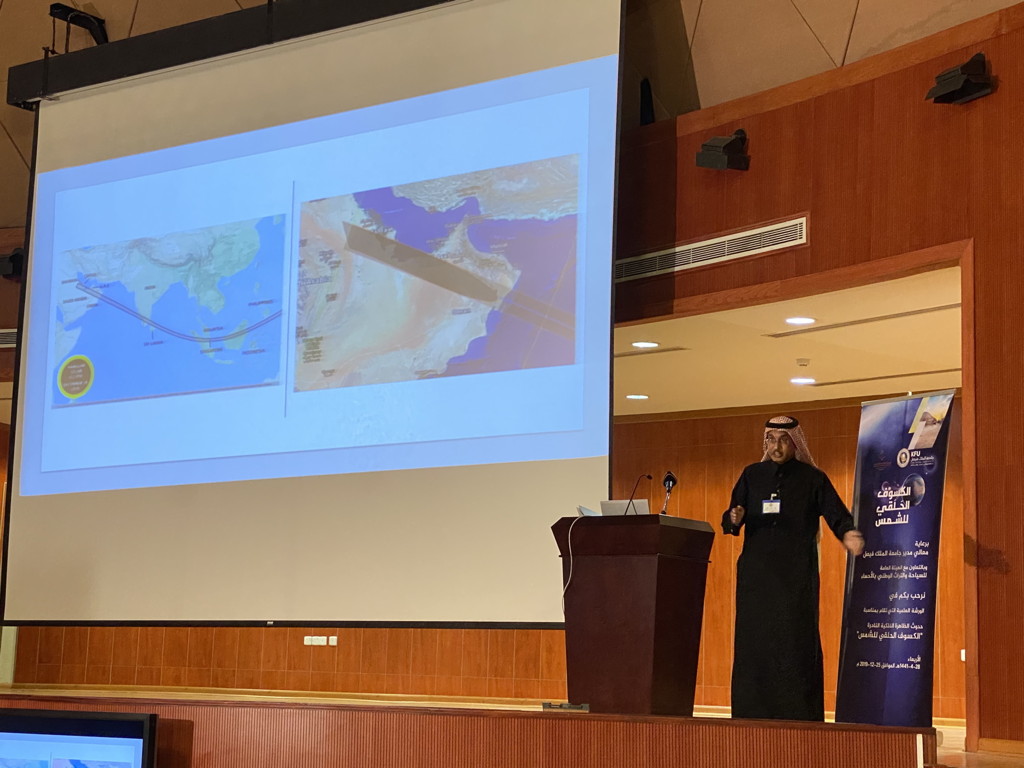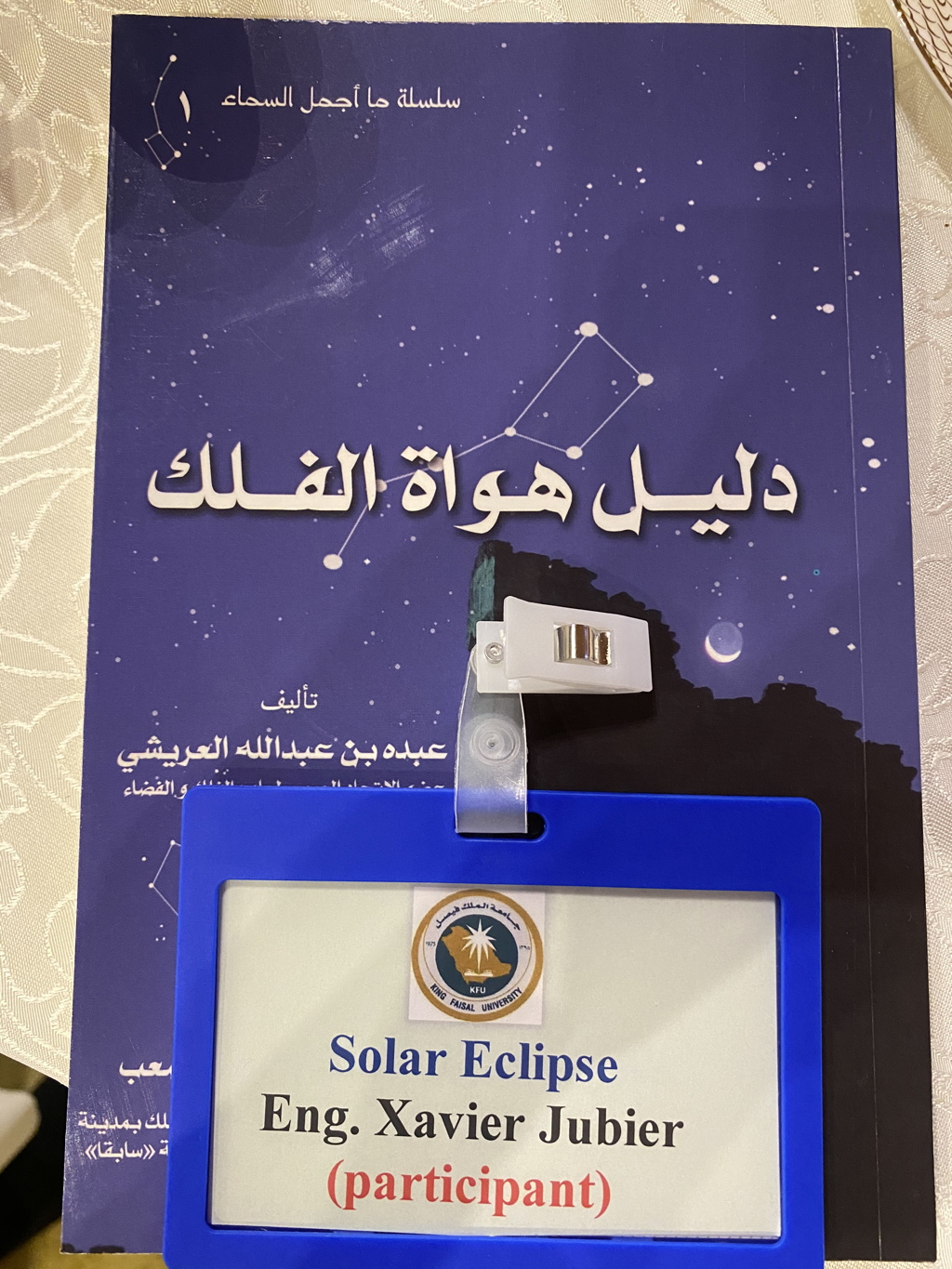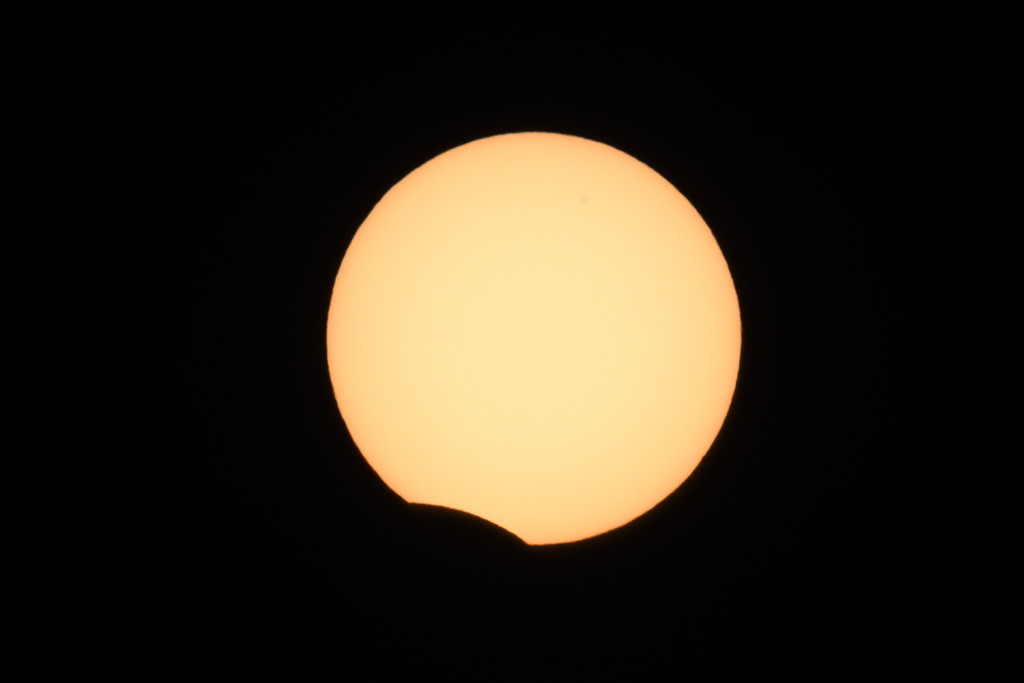
|
Annular Solar Eclipse of 2019 December 26
from Saudi Arabia
|
|
|
To observe the 2019 December 26 annular eclipse, I decided to travel to Saudi Arabia as it would allow me to experience another marvelous eclipse at sunrise such as the annular on 2013 May 10 in Western Australia. Moreover it was the perfect opportunity to visit a country being far off the beaten track for foreigners.
The process to obtain your visa for Saudi Arabia is now fairly easy at a cost of about 120€ (463.44SAR): today you just have to apply online since the end of September 2019.
You can use this solar eclipse calculator to compute the local circumstances of the eclipse, and the solar eclipse timer notifies the beginning of the various events. A time exposure calculator is there to help you choose your camera settings.
Click on thumbnails for a larger version
|
|
|
Saudi astronomers, the local population, and the media, gathered for the annular solar eclipse in the suburbs of Al-Hufuf at the "Four Mountains" encampment. They were more than 2,000 people.
However the previous annular in Saudi Arabia wasn’t in 1901 but rather in 1922, contrary to what’s indicated on the poster. Then the next annular will be already next year, i.e. 2020, however in an uninhabited area Saudi Arabia with extreme temperatures most likely. The next total solar eclipse will be 2027 August 2nd followed shortly by 2034 March 20th, while the previous one was 1952 February 25th.
|
As for myself the goal was to view the annular at sunrise from the Devil’s Thumb near Judah in Saudi Arabia. The main reason being that thanks to atmospheric refraction the annular phase would occur with the Sun at about one degree elevation which means that the whole event could be continuously observed naked eye and photographed without any solar filter. This played out quite nicely as you will see below.
Lets begin first by the eclipse circumstances computed using my tools.

Eclipse circumstances at the Devil’s Thumb with the annular at sunrise (just less than a degree for the maximum)

View of the horizon at maximum eclipse from the Devil’s Thumb (a flat horizon)

Effect of the atmospheric refraction over Saudi Arabia (courtesy of Michael Zeiler, using gridded data computed by Solar Eclipse Maestro)
|
Viewing annularity at sunrise is not easy as getting a clear sky down to the horizon is mandatory! Unfortunately haze and/or dust are quite frequent in the area and on eclipse morning, unlike the two previous days, although the sky was completely clear there was a strong wind coming from the southeast and bringing in some desert dust. While driving 1.5 hours in the dark to reach the viewing location this wind gusts could be felt. The satellite imagery at 00:30 UTC (3:30am local) before leaving the hotel was encouraging even though not as great as in the previous days. One can notice that the view from Qatar or the Omani coast would have some clouds during the eclipse, something that later prove to be true.

Cloud cover average on December 26th over 20 years in Saudi Arabia

Satellite imagery at 00:30 UTC on 2019 December 26th (red dot being roughly the targeted location)
And now the more accurate predictions using my Solar Eclipse Maestro software. Do note that I use a true photospheric solar radius of 959.98" at 1AU and not the usual 959.63" of the IAU because this value, even though official, is too small as I have already demonstrated this past few years.

Local circumstances using Solar Eclipse Maestro
|
During the few days leading to the eclipse it was paramount to do some scouting in order to validate the viewing location. Going to the Devil’s Thumb is not as easy as it may seem because you need to find a dirt track without any indication, moreover you have to do it when it’s dark and the last part is across the desert with some sandy parts. Also you need to time the drive carefully to make sure you leave the hotel early enough. In short a studious Christmas!

Devil’s Thumb near Judah shortly after sunset on December 23rd

Sunset from Al-Hofuf on December 24th with our Saudi hosts
Looking good on December 25th with a nice sunrise and green flash. This Christmas day will be a long one because once back in Al-Hofuf, after a good three-hour drive and an extremely early wakeup, I have to attend a half-day solar eclipse conference at the King Faisal University where I was cordially invited to give a talk in English as my Arabic was a little rusty ;-). At least I can see the Saudis are using my eclipse maps :D. One last thing I noticed is that the women and men were in two separate halfs in the conference room, the dividing wall being opaque and about two meters high.

December 25th sunrise from the Devil’s Thumb near Judah; all is good, back the next morning

Solar eclipse conference at the King Faisal University; oh my eclipse maps! :D

Badge for the solar eclipse conference at the King Faisal University
Then later in the afternoon we inaugurated a three-month solar eclipse exhibit inside the Al-Ahsa musueum.

Three-month solar eclipse exhibit in Al-Hofuf

Three-month solar eclipse exhibit in Al-Hofuf

Three-month solar eclipse exhibit hall in Al-Hofuf

LOL, astrological exhibition! Another reporter who has no clue…
|
After a very long Christmas day, it was time to "eclipse" myself as I needed some sleep before another extremely early wakeup and night drive! Alarm clock set at 3am and departure before 4am.

Our small group at the Devil’s Thumb near Judah on December 26th during the partial phase and after the eclipse for a well-deserved breakfast
The altazimuth mount didn’t operate properly due to an issue with the 10-AA battery holder which broke down at the beginning, and no way to find a quick solution! Bad quality Chinese made plastic… and debatable engineering. Replacing the battery holder with a small rechargeable powerbank is now likely the best solution, even though its air transportation becomes harder and restricted.

Mount and two DSLRs during the partial phase after annularity
The sky is clear, yet the morning haze quite thick with a strong headwind blowing desert dust filtering even more the solar rays; however this is perfect naked eye and there no problem continuously looking at it to enjoy the marvelous show. Do take note that all the pictures are straight out of the camera without any post-processing.

90% eclipsed Sun rising through the haze from the Devil’s Thumb near Judah; annularity in about one minute

Horns of the 87% eclipsed sunrise from the Devil’s Thumb near Judah

About one minute after the eclipsed sunrise and less than three minutes before second contact

Less than three minutes after the eclipsed sunrise and less than one minute before second contact; hints of the reddish chromosphere are visible
Six seconds before second contact the reddish chromosphere is clearly visible naked eye, a fantastic sight and most likely a world premiere during an annular.

Six seconds before second contact a huge reddish chromospheric arc is visible

Huge reddish chromospheric arc and simulation in Solar Eclipse Maestro
Two seconds before second contact some nice Baily’s beads with mingled reddish chromosphere. Once more the simulation made with Solar Eclipse Maestro does perfectly match reality which implies again that the true photospheric solar radius is larger than the value commonly in use.

Two seconds before second contact Baily’s beads and reddish chromosphere

Baily’s beads and reddish chromosphere plus simulation in Solar Eclipse Maestro
That’s it we have annularity and all this without any solar filter or eclipse glasses.

Annularity since three seconds

Annularity since about ten seconds

Maximum eclipse, about four minutes after sunrise; the top of the ring starts to be too bright
The show is ending and we have again Baily’s beads at third contact with the brightness increasing noticeably.

One second after third contact with the first Baily’s beads

Four seconds after third contact with some Baily’s beads and hints of chromosphere

Five seconds after third contact with a faint chromospheric arc, the later not visible naked eye
From then on the use of a solar filter is required.

Partial eclipse with an obscuration of 27%

Partial eclipse with an obscuration of 1%

Last thirty seconds of the partial eclipse with an obscuration of 0.05%
This annular eclipse will remain as an unforgettble memory. At the Four Mountains location in the southern outskirts of Al-Hofuf, about 2,000 people gathered for the annular eclipse. It was the place chosen by the Saudi authorities but also the astronomers, where all the media were. My presence being cordially desired, I therefore had to exercise a lot of diplomacy to avoid this circus because I suspected that I was going to be interviewed for television and/or newspapers! I kindly left this honor to one of my acquaintances :D.

Alex making the news in the Saudi newspapers

A public event

One last
My interactive eclipse maps did receive quite a few visitors for this annular solar eclipse.

The peak on December 26th is there
|
Now some bonus pictures. One of the many attractions in Saudi Arabia is Al-Ula in the northeast of the country where the Nabataean civilization flourished in the Neolithic era. What I could see rivals without any question with Petra in Jordan and there is currently a nice exhibition from October 9, 2019 to January 19, 2020March 8, 2020 in Paris at the Institute of the Arab World; all the Saudi guides I met spoke about it and were very proud to have been able to visit it. I had the privilege of visiting Madâin Sâleh as a VIP with driver and guide being the only one on-site, a real pleasure when you see the hordes of tourists in Petra.

Jabal Al Ahmar in Madâin Sâleh

Entrance at Hegra in Madâin Sâleh

Butler, driver and vehicle for the VIP tour in Madâin Sâleh
The guides, usually very competent women, wear several badges which shows that the Vision 2030 project is indeed at the heart of the deep changes underway in Saudi Arabia.

Badges on the garments of the guides in Madâin Sâleh

Jabal Al Banat in Madâin Sâleh
|
The light pollution in Saudi Arabia is quite high, hopefully the Saudis will learn to cut it down around nice locations!

Starry night sky at Jabal Al Feel (Elephant Rock area) outside Al-Ula
|
|
|
|
|
|
|














































